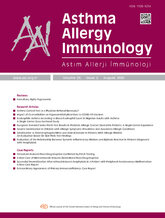


Radiocontrast agents (RCAs) are common triggers for hypersensitivity reactions, often presenting as urticaria, anaphylaxis, or exanthems. This case presents the successful desensitization of a patient requiring endovascular treatment for an arteriovenous malformation (AVM), who had a history of anaphylaxis related to iohexol.
An 18-year-old male patient was diagnosed with an AVM in the popliteal fossa. Grade 3 anaphylaxis was observed during the procedure, necessitating the administration of adrenaline, and the procedure was terminated early. The patient`s AVM required endovascular treatment, which required the use of a low dose of iodinated contrast agent. The patient underwent a skin prick test with iohexol (1/1) and an intradermal test, starting with a dilution of 1/1000, followed by dilutions of 1/100 and 1/10, all of which were negative. Due to the lack of alternative contrast agents available in our country, iohexol desensitization was planned for the angiography. A premedication regimen was followed by an 11-step rapid desensitization protocol, and the endovascular treatment procedure was successfully completed under desensitization.
There are a limited number of protocols successfully applied in patients with contrast agent anaphylaxis in the literature, and desensitization protocols for contrast agents have not yet been included in drug allergy guidelines. In this case, successful peripheral angiography was performed following the application of a rapid desensitization protocol with iohexol. Desensitization for iohexol anaphylaxis is uncommon, and more cases are needed to confirm the efficacy of this protocol.